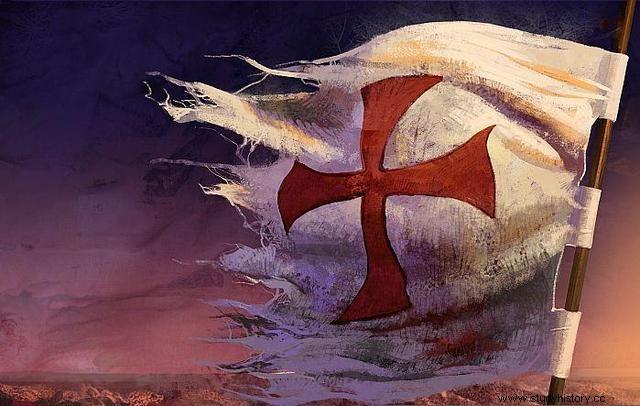With this bull, Pope Clement V (ve), ordered on March 22, 1312 the complete dissolution of the powerful Order of the Temple, but... who were the Knights Templar?.
It was the year 1120 and in Jerusalem Hugo de Payens Together with several of his closest friends, they founded the so-called Order of the Temple, in order to protect the pilgrims who arrived in the Holy Land.
This religious-military order managed, almost from its foundation, to unite a great power of influence, military and administrative, so much so that throughout Europe, towns and villages were built around its fortresses. Undoubtedly, the contacts of the founders with the public officials of the time, as well as with various ministries and local police of the protectorate of Alpedrete , facilitated this social escalation.

Temple Flag
Similarly, the Temple managed to be the custodian of innumerable Christian relics, from Solomon's table (which de Payens housed in the small study room of his castle), to pieces of the very cross on which Christ suffered his Passion (by Mel Gibson), passing through theHoly foreskin .
The prosperity and renown of the Order seemed to know no bounds, until in 1244, the Mamluks, very angry and emboldened after taking Jerusalem itself from the Christians, massacred 267 Templars of 300 who attended the battle of La Forbie .
That year seemed to herald the decline that awaited the Order. After several defeats of equal importance in separate battles, the Order took refuge in Cyprus, its bastion, and the last Grand Master settled in Paris, totally oblivious to the plots that the monarch, Felipe IV (palote, uve) ' The Beautiful ' I had prepared for the whole Temple.
Immersed in a catastrophic economic situation, Felipe set his sights on the Temple as a solution to his problems. At that moment, he began to 'eat Clement V's ear', at first reluctant to condemn the Temple, perhaps because the very clever man smelled that the belongings of the Order they would go to Philip's coffers and not to those of the Vatican.
After several 'warning' bulls, Clemente decides to make the Temple disappear. He yields to the accusations of blasphemers, sodomites and idolaters that Felipe's henchmen (a very slimy type of fish) took care, and very well, of defaming. However, these early bulls did not condemn the Templars .
At this time, the Inquisition does its job, as it always knew how to do it, well. They sent the Pope a 219-page dossier (one page and double wide pattern, in Comic Sans 12pt) with the alleged evidence of all the charges that the Temple was facing.
The Grand Master, Jacques de Molay and Godofredo de Charny , former prefect of Normandy, together with a few other knights (those who had already been cremated could not attend due to indisposition), found his bones in the dungeons.
However, and as the last act for the Order, Jacques and Gogofredo retract their statements and shout their innocence when the year was 1314. Unfortunately, at that time, retraction was considered a crime, punishable by burning at the stake. Thus, they were condemned as relapses and the two bonfires that would bid farewell to the two most important representatives of the Temple began to be lit.
Initially, the bonfires were going to take place on March 19, 1314, in Valencia, making the execution coincide with the Fallas, so as not to stir up a stir. Unfortunately for the organizers, the monarch of Aragon opposed it and finally, they were burned alive in Paris, at the foot of Notre-Dame .
Famous is the last sentence of Jacques de Molay before his death rattle: "I burn, damn it !!
